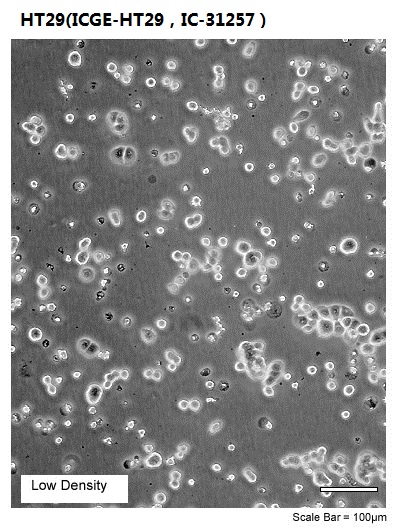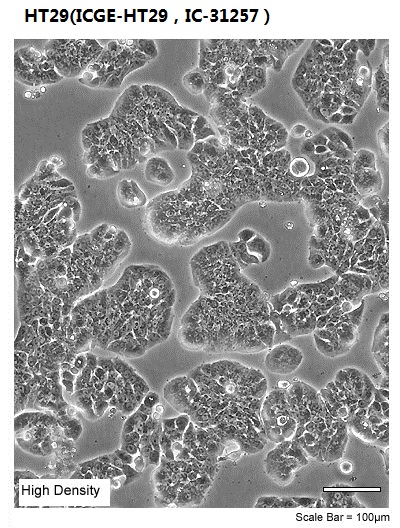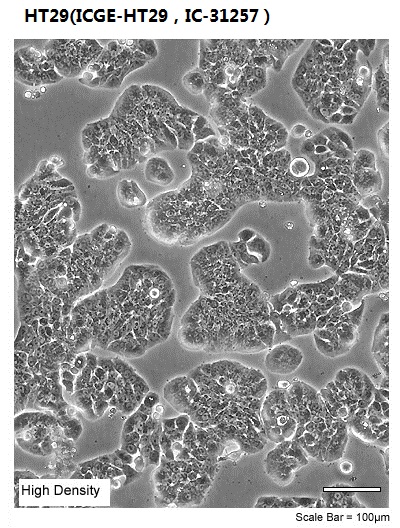


| Permits and Restrictions | |
|---|---|
| Organism | Homo sapiens, human |
| Tissue |
colon
|
| Product Format | frozen |
| Morphology | epithelial |
| Culture Properties | adherent |
| Biosafety Level |
1
Biosafety classification is based on U.S. Public Health Service Guidelines, it is the responsibility of the customer to ensure that their facilities comply with biosafety regulations for their own country. |
| Disease | colorectal adenocarcinoma |
| Age | 44 years adult |
| Gender | female |
| Ethnicity | Caucasian |
| Applications |
This cell line is a suitable transfection host.
|
| Storage Conditions | liquid nitrogen vapor temperature |
| Karyotype |
modal number = 71; range = 68 to 72. The stemline chromosome number is hypertriploid with the 2S component occurring at 2.4%. Seventeen marker chromosomes are found in most metaphases, generally in single copy per chromosome. The marker designations are: M1p-(=t(3p-;?) with a deleted short arm), t(7q;?), t(10q;?), i(13q), 19q+a; M6, ?t(8q;9q-), ?Xp, M9, 6q+, t(13;?)a, t(13;?)b, 19q+b, M14, M15, 15p+, and Xq-. Chromosome 13 is nullisomic and chromosomes 8 and 14 are generally monosomic. No Y chromosome was detected by QM band analysis. |
|---|---|
|
|
|
| Derivation |
The HT-29 line was isolated from a primary tumor in 1964 by J. Fogh using the explant culture method.
|
| Clinical Data |
44 years adult
Caucasian
female
|
| Antigen Expression |
Blood Type A; Rh+; HLA A1, A3, B12, B17, Cw5
|
| Receptor Expression | |
| Oncogene | myc +; ras +; myb +; fos +; sis +; p53 +; abl -; ros -; src - |
| Genes Expressed |
secretory component of IgA; carcinoembryonic antigen (CEA); transforming growth factor beta binding protein; mucin,myc +; ras +; myb +; fos +; sis +; p53 +; abl -; ros -; src -,Blood Type A; Rh+; HLA A1, A3, B12, B17, Cw5,HT-29 cells are negative for CD4, but there is cell surface expression of galactose ceramide (a possible alternative receptor for HIV).
|
| Cellular Products |
secretory component of IgA; carcinoembryonic antigen (CEA); transforming growth factor beta binding protein; mucin
|
| Tumorigenic | Yes |
| Effects |
Yes, in nude mice; forms well differentiated adenocarcinoma consistent with colonic primary (grade I); tumors also form in steroid treated hamsters
|
| Comments |
Ultrastructural features reported for HT-29 cells include microvilli, microfilaments, large vacuolated mitochondria with dark granules, smooth and rough endoplasmic reticulum with free ribosomes, lipid droplets, few primary and many secondary lysosomes. The cells express urokinase receptors, but do not have detectable plasminogen activator activity [PubMed ID: 8381394]. HT-29 cells are negative for CD4, but there is cell surface expression of galactose ceramide (a possible alternative receptor for HIV). The line is positive for expression of c-myc, K-ras, H-ras, N-ras, Myb, sis and fos oncogenes. The p53 antigen is overproduced, and there is a G -> A mutation in codon 273 of the p53 gene resulting in an Arg -> His substitution. N-myc oncogene expression was not detected.
There is a G -> A mutation in codon 273 of the p53 gene resulting in an Arg -> His substitution.
|
| Complete Growth Medium |
The base medium for this cell line is ATCC-formulated McCoy''''''''s 5a Medium Modified, Catalog No. 30-2007. To make the complete growth medium, add the following components to the base medium: fetal bovine serum to a final concentration of 10%. |
|---|---|
| Subculturing |
Subcultivation Ratio: A subcultivation ratio of 1:3 to 1:8 is recommended
Medium Renewal: 2 to 3 times per week
|
| Cryopreservation |
Freeze medium: Complete growth medium, 95%; DMSO, 5%
Storage temperature: liquid nitrogen vapor temperature
|
| Culture Conditions |
Atmosphere: air, 95%; carbon dioxide (CO2), 5%
Temperature: 37��C
|


